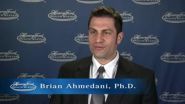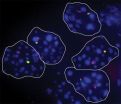(Press-News.org) Kawasaki Disease (KD) is a severe childhood disease that many parents, even some doctors, mistake for an inconsequential viral infection. If not diagnosed or treated in time, it can lead to irreversible heart damage.
Signs of KD include prolonged fever associated with rash, red eyes, mouth, lips and tongue, and swollen hands and feet with peeling skin. The disease causes damage to the coronary arteries in a quarter of untreated children and may lead to serious heart problems in early adulthood. There is no diagnostic test for Kawasaki disease, and current treatment fails to prevent coronary artery damage in at least one in 10 to 20 children and death in one in 1,000 children.
Between 10 and 20 percent of patients with KD experience fever relapse following the standard therapy with a single infusion of intravenous immunoglobulin (IVIG) and aspirin. It is known that IVIG resistance increases the risk of heart damage, most commonly a ballooning of the coronary arteries called aneurysms. These children require additional therapy to interrupt the inflammatory process that can lead to damage of the coronary arteries.
A study led by physicians at the University of California, San Diego School of Medicine and Rady Children's Hospital-San Diego looked at intensification of initial therapy for all children with KD in order to prevent IVIG-resistance and associated coronary artery abnormalities by assessing the addition of the medication infliximab to current standard therapy. The results of their study will be published in the February 24, 2014 online issue of the medical journal Lancet.
Tumor necrosis factor α (TNF α) is a molecule made by the body that plays a role in the development of inflammation in KD; therefore, treatment with a TNFa antagonist is a logical therapeutic intervention, according to the researchers. Early experience with infliximab – a monoclonal antibody that binds TNFa – showed promising results. A Phase 1 trial in children with KD and persistent fever following standard therapy found no infusion reactions or serious adverse events, and subsequent studies suggested that infliximab led to faster resolution of fever and fewer days of hospitalization than a second IVIG infusion.
The UC San Diego researchers conducted a trial of 196 subjects at two centers – Rady Children's Hospital-San Diego, a research affiliate of UC San Diego School of Medicine, and Nationwide Children's Hospital in Columbus, Ohio – to assess whether infliximab could reduce IVIG treatment resistance.
"While the addition of infliximab to primary treatment in acute KD did not reduce treatment resistance, it was safe and well-tolerated, achieved a greater reduction in the size of the left coronary artery, and reduced the number of days of fever and laboratory markers of inflammation," said the study's first author, Adriana H. Tremoulet, MD, of the UC San Diego Department of Pediatrics and the UC San Diego/Rady Children's Hospital-San Diego Kawasaki Disease Research Center. "We conclude that use of infliximab is safe in infants and children and that early treatment could help children with Kawasaki Disease with high levels of inflammation or early signs of coronary artery damage."
INFORMATION:
Additional contributors to the study include principal investigator Jane C. Burns, MD, Susan Jimenez-Fernandez, MD, John T. Kanegaye, MD, and Beth Printz, MD, of UC San Diego Department of Pediatrics and Rady Children's Hospital-San Diego; Sonia Jain, PhD, and Xiaoying Sun, MS, UCSD Department of Family and Preventive Medicine; Joan M. Pancheri, RN, of y Children's Hospital-San Diego; and Preeti Jaggi, MD, John P. Kovalchin, MD, and Octavio Ramilo, MD of Nationwide Children's Hospital and The Ohio State University, Department of Pediatrics.
Funding for the study was provided by the U.S. Food and Drug Administration, Robert Wood Johnson Foundation, and Janssen Biotech, Inc.
Study evaluates role of infliximab in treating Kawasaki disease
Antibody treatment helps children with dangerous heart disorder
2014-02-24
ELSE PRESS RELEASES FROM THIS DATE:
Scientists complete the top quark puzzle
2014-02-24
Scientists on the CDF and DZero experiments at the U.S. Department of Energy's Fermi National Accelerator Laboratory have announced that they have found the final predicted way of creating a top quark, completing a picture of this particle nearly 20 years in the making.
The two collaborations jointly announced on Friday, Feb. 21 that they had observed one of the rarest methods of producing the elementary particle – creating a single top quark through the weak nuclear force, in what is called the "s-channel." For this analysis, scientists from the CDF and DZero collaborations ...
As hubs for bees and pollinators, flowers may be crucial in disease transmission
2014-02-24
AMHERST, Mass. – Like a kindergarten or a busy airport where cold viruses and other germs circulate freely, flowers are common gathering places where pollinators such as bees and butterflies can pick up fungal, bacterial or viral infections that might be as benign as the sniffles or as debilitating as influenza.
But "almost nothing is known regarding how pathogens of pollinators are transmitted at flowers," postdoctoral researcher Scott McArt and Professor Lynn Adler at the University of Massachusetts Amherst write. "As major hubs of plant-animal interactions throughout ...
Mental health conditions in most suicide victims left undiagnosed at doctor visits
2014-02-24
VIDEO:
The mental health conditions of most people who commit suicide remain undiagnosed, even though many visit a primary care provider or medical specialist in the year before they die, according...
Click here for more information.
DETROIT – The mental health conditions of most people who commit suicide remain undiagnosed, even though many visit a primary care provider or medical specialist in the year before they die, according to a national study led by Henry Ford Health ...
Cancer patients turning to mass media and non-experts for info
2014-02-24
PHILADELPHIA (February 24, 2014) – The increasing use of expensive medical imaging procedures in the U.S. like positron emission tomography (PET) scans is being driven, in part, by patient decisions made after obtaining information from lay media and non-experts, and not from health care providers.
That is the result from a three-year-long analysis of survey data, and is published in the article , "Associations between Cancer-Related Information Seeking and Receiving PET Imaging for Routine Cancer Surveillance – An Analysis of Longitudinal Survey Data," appearing in ...
JCI early table of contents for Feb. 24, 2014
2014-02-24
PPAR-γ agonist reverses cigarette smoke induced emphysema in mice
Pulmonary emphysema results in irreversible lung damage and is most often the result of long term cigarette smoke exposure. Immune cells, such as macrophages and myeloid dendritic cells (mDCs) accumulate in the lungs of smokers with emphysema and release cytokines associated with autoimmune and inflammatory responses. In this issue of the Journal of Clinical Investigation Farrah Kheradmand and colleagues at Baylor University found that peroxisome proliferator activated receptor-γ (PPARγ) ...
Mdm2 suppresses tumors by pulling the plug on glycolysis
2014-02-24
Cancer cells have long been known to have higher rates of the energy-generating metabolic pathway known as glycolysis. This enhanced glycolysis, a phenomenon known as the Warburg effect, is thought to allow cancer cells to survive the oxygen-deficient conditions they experience in the center of solid tumors. A study in The Journal of Cell Biology reveals how damaged cells normally switch off glycolysis as they shut down and shows that defects in this process may contribute to the early stages of tumor development.
Various stresses can cause cells to cease proliferating ...
Two-pronged approach successfully targets DNA synthesis in leukemic cells
2014-02-24
A novel two-pronged strategy targeting DNA synthesis can treat leukemia in mice, according to a study in The Journal of Experimental Medicine.
Current treatments for acute lymphoblastic leukemia (ALL), an aggressive form of blood cancer, include conventional chemotherapy drugs that inhibit DNA synthesis. These drugs are effective but have serious side effects on normal dividing tissues.
In order to replicate, cells must make copies of their DNA, which is made up of building blocks called deoxyribonucleotide triphosphates (dNTPs). Cells can either make dNTPs from scratch ...
Blocking autophagy with malaria drug may help overcome resistance to melanoma BRAF drugs
2014-02-24
PHILADELPHIA— Half of melanoma patients with the BRAF mutation have a positive response to treatment with BRAF inhibitors, but nearly all of those patients develop resistance to the drugs and experience disease progression.
Now, a new preclinical study published online ahead of print in the Journal of Clinical Investigation from Penn Medicine researchers found that in many cases the root of the resistance may lie in a never-before-seen autophagy mechanism induced by the BRAF inhibitors vermurafenib and dabrafenib. Autophagy is a process by which cancer cells recycle ...
Like mom or dad? Some cells randomly express one parent's version of a gene over the other
2014-02-24
Cold Spring Harbor, NY – We are a product of our parents. Maybe you have your mother's large, dark eyes, and you inherited your father's infectious smile. Both parents contribute one copy, or allele, of each gene to their offspring, so that we have two copies of every gene for a given trait – one from mom, the other from dad. In general, both copies of a gene are switched on or off as an embryo develops into an adult. The "switching on" of a gene begins the process of gene expression that ultimately results in the production of a protein.
Occasionally, a cell will arbitrarily ...
Caring for patients with multiple chronic conditions -- New research and future challenges
2014-02-24
Philadelphia, Pa. (February 21, 2014) – The millions of Americans living with more than one chronic disease are at high risk of poor health outcomes, and account for a disproportionate share of health care costs. A special March supplement to Medical Care presents updates from the Agency for Healthcare Research and Quality's (AHRQ) Multiple Chronic Conditions (MCC) Research Network, formed to address knowledge gaps and research challenges in meeting the complex health care needs of this growing population. The journal is published by Lippincott Williams & Wilkins, a part ...
LAST 30 PRESS RELEASES:
Injectable breast ‘implant’ offers alternative to traditional surgeries
Neuroscientists devise formulas to measure multilingualism
New prostate cancer trial seeks to reduce toxicity without sacrificing efficacy
Geometry shapes life
A CRISPR screen reveals many previously unrecognized genes required for brain development and a new neurodevelopmental disorder
Hot flush treatment has anti-breast cancer activity, study finds
Securing AI systems against growing cybersecurity threats
Longest observation of an active solar region
Why nail-biting, procrastination and other self-sabotaging behaviors are rooted in survival instincts
Regional variations in mechanical properties of porcine leptomeninges
Artificial empathy in therapy and healthcare: advancements in interpersonal interaction technologies
Why some brains switch gears more efficiently than others
UVA’s Jundong Li wins ICDM’S 2025 Tao Li Award for data mining, machine learning
UVA’s low-power, high-performance computer power player Mircea Stan earns National Academy of Inventors fellowship
Not playing by the rules: USU researcher explores filamentous algae dynamics in rivers
Do our body clocks influence our risk of dementia?
Anthropologists offer new evidence of bipedalism in long-debated fossil discovery
Safer receipt paper from wood
Dosage-sensitive genes suggest no whole-genome duplications in ancestral angiosperm
First ancient human herpesvirus genomes document their deep history with humans
Why Some Bacteria Survive Antibiotics and How to Stop Them - New study reveals that bacteria can survive antibiotic treatment through two fundamentally different “shutdown modes”
UCLA study links scar healing to dangerous placenta condition
CHANGE-seq-BE finds off-target changes in the genome from base editors
The Journal of Nuclear Medicine Ahead-of-Print Tip Sheet: January 2, 2026
Delayed or absent first dose of measles, mumps, and rubella vaccination
Trends in US preterm birth rates by household income and race and ethnicity
Study identifies potential biomarker linked to progression and brain inflammation in multiple sclerosis
Many mothers in Norway do not show up for postnatal check-ups
Researchers want to find out why quick clay is so unstable
Superradiant spins show teamwork at the quantum scale
[Press-News.org] Study evaluates role of infliximab in treating Kawasaki diseaseAntibody treatment helps children with dangerous heart disorder






